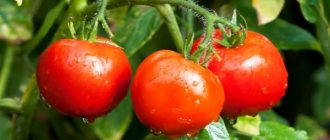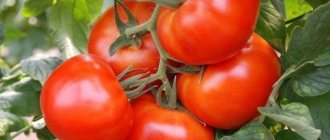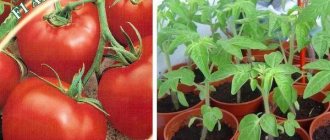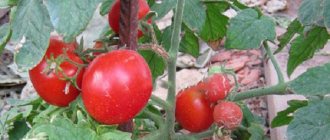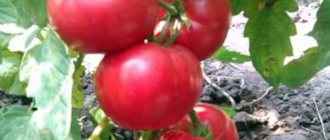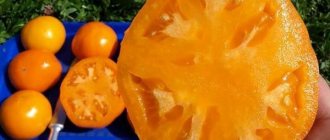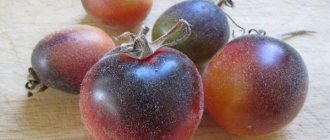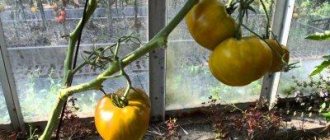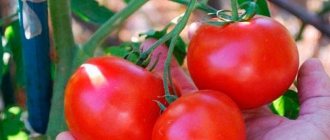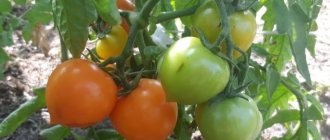Description of culture
Tomatoes Nadezhda F1 are an early ripening hybrid in the first generation . The bushes are of a determinate type, that is, they have limited growth, reaching a height of 60–75 cm in open ground and 150 cm in greenhouse conditions.
The stems of the bush are dense, light green in color, the leaves are dark green, medium in size, the inflorescences are of an intermediate type. The bush is spreading and reaches 50–60 cm in width. You can see the fruits of the hybrid in the photo.
Distinctive features
Hybrid Nadezhda has positive characteristics that allow even novice gardeners to start growing it:
- resistant to both low negative temperatures and drought and heat;
- early fruiting period;
- does not require special feeding and care;
- resistant to diseases;
- gives a bountiful harvest.
Fruit characteristics
Hybrid tomatoes Nadezhda are universal in use. They are consumed both fresh and after heat treatment. The average weight of one fruit is 70–90 g when grown in open ground, up to 150–200 g in greenhouses.
The skin of the fruit is dense, glossy, and a ripe tomato has a bright red color. The pulp is dense, juicy, with a small amount of seeds, and has a rich and sweet taste.
Productivity
The fruits ripen quickly; in the absence of frost, rain or drought, the first harvest is harvested within 95–100 days after emergence. With proper agricultural technology, up to 5–6 kg of plantings are harvested from 1 m2 of dacha plots; in fields from 1 hectare the values reach 100–120 tons.
The first third of the fruits ripen in the second decade of June. Fruiting lasts until approximately mid-August, the remainder of the harvest is harvested as it ripens.
Hybrid characteristics
The possibility of using the Nadezhda tomato for commercial purposes is due, among other things, to the fact that the crop can easily withstand transportation, and the marketable appearance of the tomatoes is preserved for at least a month. In addition, it is an “all-weather” hybrid, easily tolerating extreme cold and heat. Resistant to verticillium and fusarium, it manages to bear fruit before late blight arrives in the beds.
The purpose of the fruits is salad, they are considered quite tasty, although official assessments of taste vary between “good” and “excellent”. The taste is described as sweet and sour. Small tomatoes are very well suited for whole-fruit canning: they do not crack during heat treatment. You can make juice and sauces from them, and even freeze them.
The fruits of the Nadezhda tomato have a completely regular shape, about which in ancient times they said: “greenhouse. »
Despite all the discrepancies with the overall yield, it is noted that in the first ten days of fruiting, the bushes produce approximately a third of the total number of tomatoes. And if the first fruits in a number of regions can be harvested already at the end of June, then the last ones can be harvested at the very end of summer: the fruiting of this hybrid is extended.
The main advantages of the variety include:
- adaptability to almost any weather;
- excellent transportability of the crop;
- long-term preservation of fruits;
- resistance to most diseases;
- excellent presentation of the fruit;
- early ripeness;
- very good taste;
- versatility of use.
Relative disadvantages include the need to form bushes (not all determinants require this procedure), as well as high requirements for soil fertility: without sufficient nutrition, cutting yields drop.
In general, the Nadezhda tomato strongly resembles the well-known Sanka varieties of the same breeder or Lyana of the Transnistrian selection. Their yield, the appearance of the fruit, and many other indicators are comparable. But if Lyana’s taste qualities are clearly rated as excellent, and Sanka’s as good, then Nadezhda’s taste qualities are rated as intermediate.
Tomato Sanka from Pancev’s collection is much more famous among our gardeners
How to grow seedlings
When growing Nadezhda F1 tomatoes through seedlings, the harvest can be obtained two weeks earlier than when planted in open ground.
Seed preparation
Hybrid seeds are sold ready-made, so they are sown dry and do not require special treatment with growth stimulants or bactericidal solutions. Sowing takes place in March - early April.
Attention ! Seeds should be purchased every year, since if you independently collect planting material from a previous harvest, there is no guarantee that the parental characteristics will be preserved; a plant with other properties may grow.
Container and soil
For planting, use special cassettes, boxes or peat tablets and cups with drainage holes. The soil can be purchased ready-made or prepared independently. The soil should contain peat, turf soil, humus and sawdust in equal proportions.
To disinfect, before planting seeds, the soil is doused with boiling water or calcined in the oven.
Sowing
The container is filled with soil mixture 3-4 cm below the edge, the soil is moistened, covered with film and left under it for a day to evenly distribute moisture. Then small holes are made in the soil into which the planting material is placed. The planted seeds are covered with soil and watered. The container is covered with film until the first shoots appear. The air temperature is maintained at a level not lower than +25 °C.
Growing and care
As a rule, the first shoots appear 7–10 days after sowing the seeds. After the sprouts appear, it is necessary to maintain a temperature of +15 °C for a week, then maintain the daytime temperature to +24 °C, and the night temperature to +12 °C.
After 10 days, the first fertilizing is done, after a two-week break, fertilizers are applied again.
To prevent planting in a permanent place from becoming too stressful for tomatoes, they need to be hardened off. The seedlings are taken out into fresh air (at a temperature of at least +12 ° C), starting from half an hour and gradually increasing the time.
How to grow tomatoes
The agricultural technology of the Nadezhda hybrid consists of standard procedures for growing other tomatoes.
Landing
The seedlings are placed in a permanent growing place on the 60–65th day of the bush’s life. Planting time depends not only on the age of the tomatoes, but also on the degree of soil warming. Before planting, seedlings are fertilized with a complex solution.
Planting technology:
- at a distance of at least 60 cm, dig holes 15–20 cm deep;
- the seedling with an earthen lump is released from the seedling container and placed in the hole;
- the roots are densely sprinkled with earth until a small mound is formed on the surface;
- the bush is watered abundantly with warm water;
- the seedling is mulched with ash, sawdust or film.
Reference. The optimal time for planting in the ground is from the end of May to the beginning of June, in a greenhouse - the end of April.
Care
To get a large harvest of tomatoes, you need to care for the plants in accordance with the rules of agricultural technology, which include:
- watering 1-2 times a week as the top soil layer dries;
- regular weeding and loosening of the soil;
- hilling bushes 2-3 times per season;
- formation of a bush (only one main stem is left), pinching;
- gartering the bush as the plant grows when it reaches a height of 40 cm;
- monthly fertilizing with potassium and phosphorus fertilizers, cow or bird droppings.
Important! Do not use fertilizers with high nitrogen content. Its excess leads to the growth of excess stems and leaves, blocking the formation of fruit ovaries.
Features of cultivation and possible difficulties
Tomato Nadezhda F1 is considered an unpretentious crop, however, it requires constant care and compliance with the correct growing conditions. This will allow you to achieve high yields and better taste of the fruit.
When watering, avoid getting water on the leaves . It is important to ensure sufficient soil moisture during the period of ovary formation, otherwise the fruits may grow unsweetened and small.
If there is an excess of weeds or rapid evaporation of moisture, they resort to mulching - covering the ground around the plants with organic material, for example, fallen leaves, grass, sawdust or straw.
Diseases and pests
With proper agricultural practices, the risk of disease in the hybrid is minimal, so spraying with chemicals is used less frequently than with other nightshades. To prevent diseases such as fusarium, late blight, and verticillium, water the soil with a solution of copper sulfate before planting.
Pests such as slugs, aphids, Colorado potato beetles and thrips most often appear in open beds. To combat them, various insecticides or spraying with an aqueous solution of hydrogen peroxide are used. Large insects and larvae are collected by hand.
Bush care
Basic measures for caring for plants of the “Nadezhda” variety:
- Moderate watering with warm, settled water;
- Frequent loosening of the soil in the beds;
- Weeding and weed removal;
- Feeding with organic matter and nutritional mineral complexes.
REFERENCE: During the season, tomatoes are fed 3-4 times with diluted mullein or complex mineral fertilizers.
Plants need shaping. For better growth, the lower leaves and side shoots above the third cluster are removed from the bushes. To prevent the branches from breaking off under the weight of the fruit, they are promptly tied to the supports. Mulching will help get rid of weeds on the site.
The nuances of growing in open ground and greenhouses
When choosing a landing site, you need to remember the differences and subtleties in care.
In open ground:
- seedlings are planted only in heated soil;
- in the first few weeks after planting, the bushes are covered with film to prevent hypothermia;
- self-watering alternates with natural precipitation;
- if the precipitation level is high, cover the plants so that the soil does not become waterlogged;
- stakes are used to tie up bushes;
- There is a higher risk of developing diseases and the appearance of harmful insects, so plants are treated with chemicals.
In the greenhouse:
- seedlings are planted 1–1.5 months earlier;
- systematically ventilate the greenhouse so that excess moisture does not accumulate;
- the bush is formed more often, since it grows more spreading and tall than in open space.
Harvesting and application
The first harvest should be expected 90 days after planting the seedlings. The fruits are collected as they ripen. Their weight varies from 80 to 200 g. Until mid-August, all tomatoes are harvested, regardless of the degree of ripeness, since the life cycle of the bush is completed by this moment, the leaves turn yellow and begin to die.
Ripe tomatoes have a short shelf life, so they are eaten immediately or used for harvesting. Green fruits or blanzhe ripeness are collected for long-term storage or further transportation. Used to prepare salads, sauces, and tomato juice.
Nadezhda f1 tomatoes are suitable for both private and industrial cultivation.
Reference . Fruits at the initial stage of ripeness are best stored in wooden boxes covered with straw or heat-insulating material. Each fruit is wrapped in paper. The box is stored in a cellar or on a warm loggia, covered from excess light.
Advantages and disadvantages of the variety
The Nadezhda F1 hybrid has many advantages. Gardeners note among the main ones:
- resistance to temperature changes;
- presentation and taste of ripe fruits;
- high productivity;
- long shelf life (1.5–2 months);
- compactness of the bush, allowing you to save space and get maximum yield per square meter of planting;
- immunity to infectious and fungal diseases characteristic of nightshades.
The disadvantages include:
- the need for regular feeding and watering;
- systematic pinching to obtain maximum yield;
- the requirement of tomatoes for looseness and nutritional value of the soil;
- need for garter;
- inability to obtain planting material on your own.
Lake of Hope
Tomato Nadezhda F1 should not be confused with the younger namesake hybrid Lake of Nadezhdy, which was created by breeder L. Myazina.
Lake Nadezhda is higher, it has few leaves and they are much more massive , the weight of the fruit is 250–300 g, while there are fewer fruits on one bush than Nadezhda F1. When purchasing planting material, you should pay special attention to the characteristics so as not to confuse these two hybrids.
Why do people want to sleep? Physiological causes of drowsiness (why you constantly want to sleep - possible reasons)
Farmer reviews
Gardeners who grew the Nadezhda F1 hybrid on their plots generally note its high yield.
Irina Ivanovna, Voronezh: “I am an experienced gardener, I tried many varieties of tomatoes, but did not get the desired results. Two years ago, a friend recommended Nadezhda F1, which captivated me. The tomatoes grow well even in the garden, the bushes all bore fruit as one, and there was so much harvest that I didn’t have time to plant them, so I gave all my relatives a bag of tomatoes.”
Nadezhda Nikolaevna, Tver: “I planted this variety last year. To save time, I bought ready-made seedlings, but I was very worried about how they would take root. Almost all the bushes survived, although I only went to the dacha on weekends. I ate tomatoes all summer and made preparations for the winter. The fruits are juicy, beautiful and tasty.”
Vera, St. Petersburg: “I was very lucky to stumble upon this hybrid. In our latitude and weather it is very difficult to grow anything, let alone a good harvest. But the Nadezhda F1 tomato turned out to be so tenacious and strong that my whole family had fresh vegetables for the table in the summer. My husband said that now we can build a second greenhouse with such a harvest!”
Super tomatoes from Gardens of Russia on video
If you grew Nadezhda tomatoes, please write whether you liked them or not. What was the yield and taste of the fruits in your climatic conditions? How do you rate the disease resistance of this tomato? Briefly describe the advantages and disadvantages of this tomato in your opinion. If possible, attach to the comment a photo of the entire bush as a whole or individual fruits that you grew. Thank you!
Your reviews of the Nadezhda tomato and additions to the description will help many gardeners evaluate this variety more objectively and decide whether it is worth planting or not.
